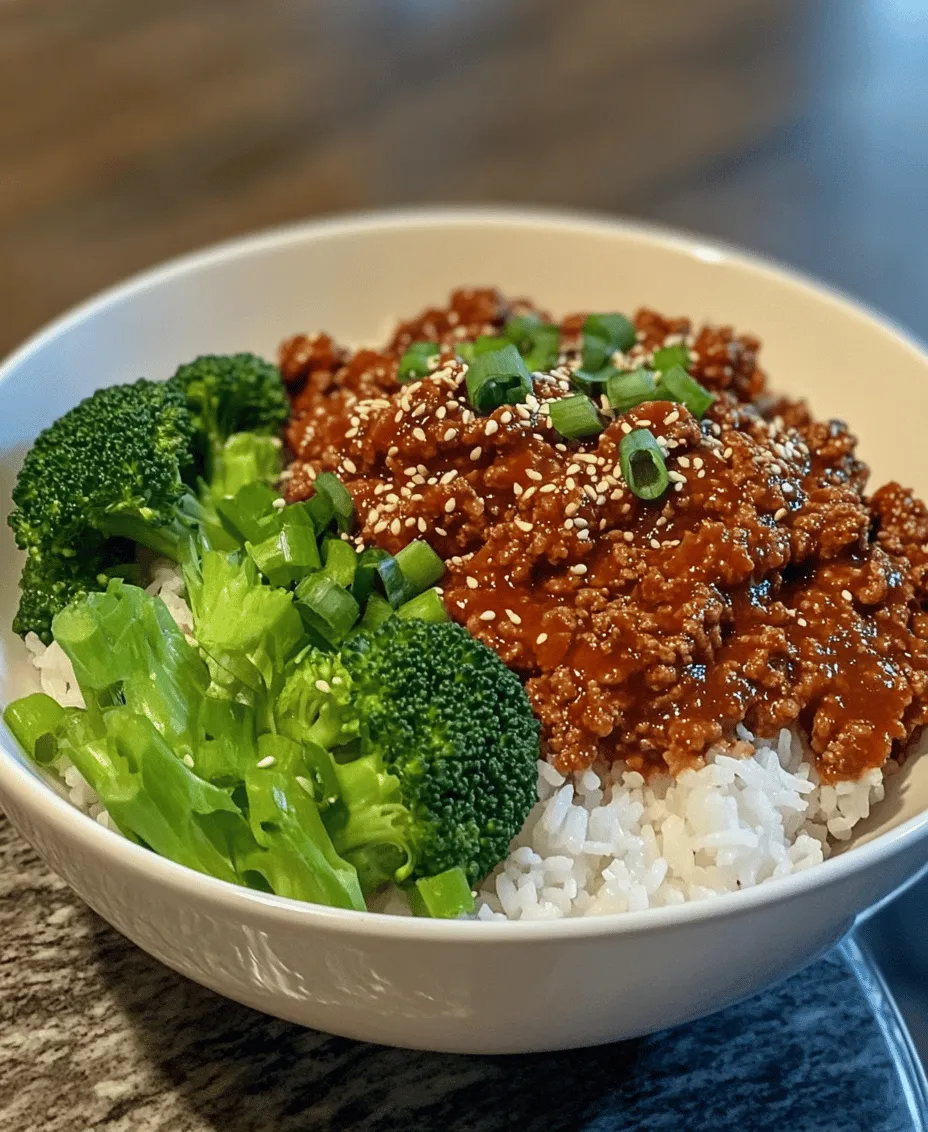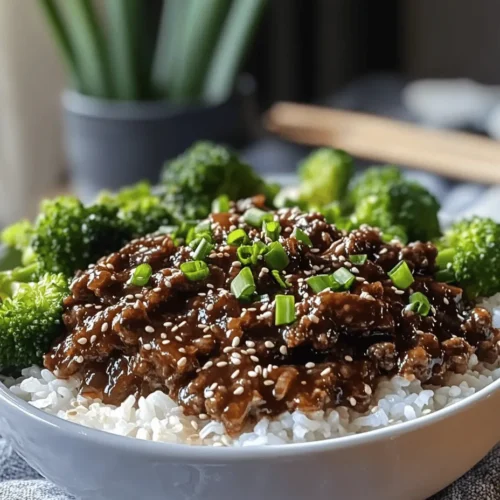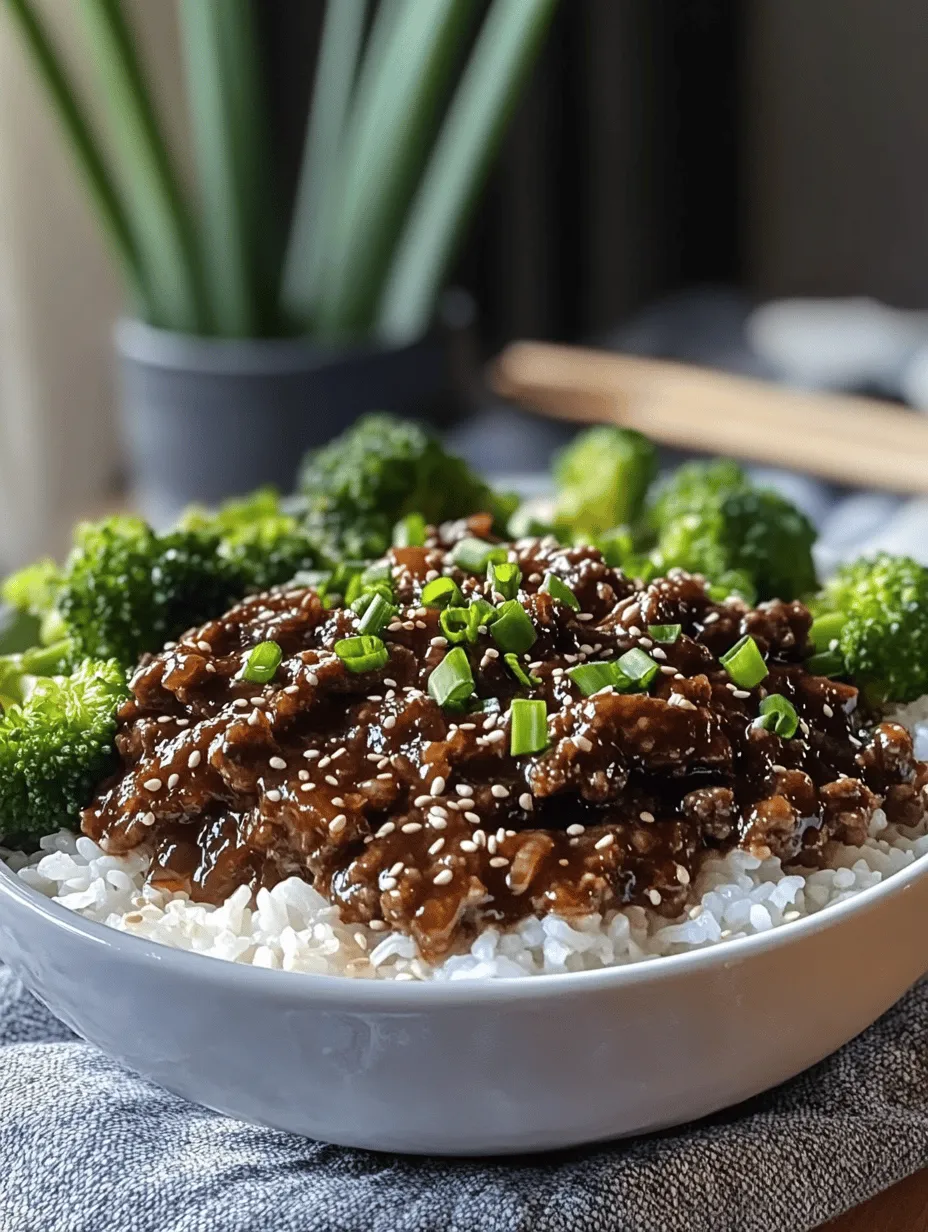Introduction to Korean Ground Beef Bowl
Korean cuisine has gained immense popularity around the globe, celebrated for its bold flavors, diverse ingredients, and rich culinary traditions. From the iconic bibimbap to the flavorful bulgogi, Korean dishes are often characterized by a harmonious balance of savory, sweet, and spicy elements. Among these delightful offerings is the Korean Ground Beef Bowl, a dish that encapsulates the essence of Korean cooking while providing a comforting and satisfying meal.
The Korean Ground Beef Bowl is not only delicious but also remarkably easy to prepare, making it an excellent choice for busy weeknights or leisurely weekends. This dish features ground beef sautéed with a medley of aromatic ingredients and served over a bed of rice, creating a satisfying meal that can be customized to suit individual tastes. The key to this dish lies in the balance of flavors: the savory richness of the beef is complemented by the sweetness of brown sugar, the umami depth of soy sauce, and the spicy kick from gochujang, a traditional Korean chili paste.
In this article, we will delve into the essential ingredients that make this dish truly special and provide you with a step-by-step guide to creating a Korean Ground Beef Bowl that will impress your family and friends.
Understanding the Key Ingredients
Ground Beef
The first and foremost ingredient in our Korean Ground Beef Bowl is, of course, ground beef. When selecting ground beef for this recipe, it’s essential to consider the fat content. A beef blend with 80% lean meat and 20% fat is ideal, as it provides the right amount of richness without being overly greasy. The fat helps to keep the beef moist and flavorful during cooking. However, if you prefer a leaner option, ground turkey or chicken can also be used, although the flavor profile may differ slightly.
The Role of Aromatics
Aromatics like garlic and ginger play a crucial role in enhancing the overall taste of the dish. Freshly minced garlic brings an aromatic sharpness that complements the savory notes of the beef, while ginger adds a subtle warmth and earthiness. Both ingredients are staples in Korean cooking and are essential for building layers of flavor. For the best results, use fresh garlic and ginger rather than powdered versions, as they offer a more vibrant taste.
Soy Sauce
Soy sauce is the cornerstone of Korean flavor profiles, offering depth and umami to many dishes, including our Ground Beef Bowl. It adds saltiness and richness, enhancing the overall flavor of the dish. For this recipe, a high-quality, low-sodium soy sauce is recommended, as it allows for better control over the saltiness of the dish without compromising flavor. If you’re looking for an authentic twist, consider using Korean soy sauce (ganjang), which has a unique flavor profile that differs slightly from its Chinese counterpart.
Brown Sugar
To achieve the perfect balance of flavors, brown sugar is introduced into the mix. It adds a hint of sweetness that counteracts the savory components of the beef and soy sauce. This sweetness is crucial in creating a well-rounded flavor profile that makes the dish so addictive. When using brown sugar, you can opt for light or dark varieties, depending on how rich you want the flavor to be. Dark brown sugar has a higher molasses content, resulting in a deeper, more complex sweetness.
Gochujang
No Korean dish would be complete without gochujang, a fermented chili paste that offers a unique combination of heat, sweetness, and umami. Its complex flavor profile elevates the dish, bringing a level of authenticity that is hard to replicate with other ingredients. Gochujang varies in heat levels, so it’s essential to taste the paste before adding it to your dish. Start with a small amount, and adjust according to your spice tolerance. If you cannot find gochujang, a mix of miso paste and chili powder can serve as a substitute, although the flavor won’t be as rich.
Vegetables
Incorporating vegetables into your Korean Ground Beef Bowl not only enhances its nutritional value but also adds color and texture to the dish. Common choices include diced bell peppers, shredded carrots, and sliced green onions, all of which can provide different flavors and crunch. Feel free to customize your vegetable selection based on what you have on hand or your personal preferences. Adding a variety of vegetables also allows for a more vibrant and visually appealing dish, making it even more enjoyable to eat.
Step-by-Step Recipe Guide
Preparing the Ingredients
Before diving into cooking, preparation is key to a seamless cooking experience. Start by gathering all your ingredients and measuring them out. This ensures you have everything on hand and minimizes the risk of forgetting crucial elements during the cooking process.
For the ground beef, you will need approximately one pound for a satisfying serving size. Mince 3-4 cloves of garlic and grate a small piece of ginger—about a tablespoon should suffice. Chop your chosen vegetables, aiming for uniform pieces to promote even cooking. If you prefer a milder flavor profile, consider using less garlic and ginger, or even omitting one of them altogether.
Cooking the Ground Beef
Heat a large skillet or wok over medium-high heat and add a tablespoon of oil, such as vegetable or sesame oil. Once the oil is hot, add the ground beef to the skillet, breaking it apart with a spatula. Allow the beef to cook undisturbed for a few minutes until it starts to brown. This browning process is essential, as it develops deep flavors through the Maillard reaction.
Once the beef is browned, continue to stir occasionally until it is fully cooked through. Any excess grease can be drained off, depending on your preference for richness in the final dish. It’s essential to cook the beef thoroughly, as undercooked meat can lead to foodborne illnesses.
Incorporating Aromatics
With the ground beef cooked to perfection, it’s time to introduce the aromatics. Add the minced garlic and ginger to the skillet, stirring them into the beef. This step is critical, as garlic and ginger release their aromatic compounds best when cooked briefly before they become overly browned or burnt. Sauté the mixture for about one minute, just until the garlic becomes fragrant and lightly golden. Be cautious not to overcook the aromatics, as they can turn bitter if left on the heat for too long.
Crafting the Sauce
The next step involves crafting the sauce that will coat the beef and vegetables, enhancing the overall flavor of the dish. In a small bowl, combine soy sauce, brown sugar, and gochujang. Mix well until the sugar is dissolved and the ingredients are thoroughly incorporated. The balance of savory, sweet, and spicy is what makes this sauce special, so taste as you go and adjust the quantities if needed. If you like more heat, feel free to add additional gochujang; if you prefer it sweeter, increase the brown sugar slightly.
Simmering the Beef
Once the sauce is ready, pour it over the beef in the skillet, stirring to combine. If you’re adding vegetables, toss them in at this stage, allowing them to cook briefly in the sauce. The goal is to simmer everything together for about 2-3 minutes, allowing the flavors to meld beautifully. The sauce will thicken slightly, coating the beef and vegetables in a glossy, delicious finish.
As the beef simmers, the aroma wafting through your kitchen will be irresistible, heightening anticipation for the meal to come. This step is crucial in ensuring that each bite is bursting with flavor, showcasing the harmonious balance that defines Korean cuisine.
—
In this first part of our article, we have explored the delightful world of the Korean Ground Beef Bowl, from understanding its key ingredients to preparing the dish step by step. The next section will continue with serving suggestions, variations, and tips for perfecting this delicious recipe, helping you create a dish that not only satisfies your cravings but also impresses everyone at the table. Stay tuned for more insights on this culinary adventure!

Assembling the Bowl: Presentation Tips for a Beautiful Dish
When it comes to serving the Korean Ground Beef Bowl, presentation is key. A beautifully assembled bowl not only enhances the dining experience but also showcases the vibrant colors and textures of the ingredients. Start by choosing a wide, shallow bowl to allow for an appealing arrangement of each component.
Begin by layering the rice at the bottom of the bowl. A scoop of warm, fluffy steamed rice acts as the perfect foundation. Next, add a generous portion of the savory ground beef mixture on one side of the bowl. This not only creates a striking visual contrast but also allows the flavors to mingle as you eat.
To add freshness and color, incorporate a handful of sautéed vegetables—think vibrant bell peppers, tender broccoli, or crunchy carrots. Arrange them artistically alongside the beef. If you’re using any additional toppings like sliced scallions, sesame seeds, or pickled vegetables, sprinkle them on top for a finishing touch. A drizzle of sesame oil or a light soy sauce can also enhance the visual appeal while adding an extra layer of flavor.
Garnishing: The Final Touches that Elevate the Dish
Garnishing is where your Korean Ground Beef Bowl can truly shine. Consider the following suggestions to elevate your dish:
1. Fresh Herbs: Finely chop green onions and sprinkle them generously over the top. The bright green color not only looks appealing but also adds a fresh flavor.
2. Sesame Seeds: Toasted sesame seeds add a nutty flavor and a delightful crunch. A simple sprinkle over the bowl can make a big difference.
3. Chili Flakes or Slices: If you enjoy a bit of heat, consider adding some sliced fresh chilies or a sprinkle of chili flakes. This not only enhances flavor but can also add a pop of color.
4. Egg: A fried egg with a runny yolk is a popular addition to many Korean dishes. Placing it on top of the beef adds a creamy texture that complements the savory flavors beautifully.
Nutritional Information
Understanding the nutritional breakdown of your Korean Ground Beef Bowl can help you make informed choices. Here’s a general breakdown per serving:
– Calories: Approximately 500-600 calories, depending on portion sizes and specific ingredients used.
– Protein: Around 25-30 grams, thanks to the ground beef and any added eggs or tofu.
– Fats: Approximately 20 grams, primarily from the beef and any cooking oils or toppings.
– Carbohydrates: Roughly 50-60 grams, mainly from the rice and vegetables.
Health Benefits Associated with Key Ingredients
The Korean Ground Beef Bowl features several ingredients that offer health benefits:
– Ground Beef: A great source of protein and essential nutrients like iron and zinc, which are vital for immune function and energy levels.
– Vegetables: Rich in vitamins and antioxidants, vegetables like bell peppers and broccoli contribute to overall health by supporting your immune system and promoting good digestion.
– Rice: While it provides carbohydrates for energy, opting for brown rice or quinoa can enhance fiber content, promoting better gut health.
Modifications for Dietary Preferences
Should you wish to modify the recipe for dietary preferences, here are a few suggestions:
– Lean Meats: For a healthier option, substitute ground beef with ground turkey or chicken. These leaner meats deliver the same flavors while reducing fat content.
– Vegetarian Options: Use plant-based ground meat alternatives or diced tofu. You can also increase the quantity of vegetables for a hearty meatless bowl.
– Gluten-Free: Ensure that the soy sauce you use is gluten-free or opt for tamari sauce, a gluten-free alternative.
Serving Suggestions and Pairings
To create a well-rounded meal, consider these side dishes that complement the Korean Ground Beef Bowl:
– Kimchi: This popular Korean side dish, made from fermented vegetables, adds a spicy and tangy flavor that pairs beautifully with the savory beef.
– Korean Pancakes (Pajeon): These savory pancakes, filled with scallions and vegetables, make for a delightful and textural contrast to your bowl.
– Steamed Bok Choy: A light and nutritious green vegetable, steamed bok choy offers a mild flavor and crunchy texture.
Beverage Pairings
To enhance your dining experience, consider these beverage pairings:
– Traditional Korean Drinks: Pair your meal with a refreshing glass of Sikhye, a sweet rice drink that complements the flavors of the meal.
– Modern Alternatives: If you prefer something non-alcoholic, a light sparkling water with a splash of lemon can cleanse the palate. For those who enjoy alcoholic beverages, a light lager or an Asian rice wine can complement the dish beautifully.
Ideas for Leftovers
If you find yourself with leftovers, there are plenty of creative options to utilize extra ingredients:
– Fried Rice: Combine leftover rice and beef with some scrambled eggs and vegetables for a quick fried rice dish.
– Stuffed Peppers: Use the ground beef mixture to stuff bell peppers and bake them for a wholesome meal.
– Wraps: Turn leftover ingredients into delicious wraps using lettuce leaves or tortillas, adding fresh veggies and sauces for extra flavor.
Cultural Significance of Korean Cuisine
Korean cuisine is rich with history and cultural significance. Originating from a tradition of communal dining, meals are often shared among family and friends, fostering a sense of togetherness. The concept of “banchan” (small side dishes) is integral to Korean dining, allowing for a variety of flavors and textures to be enjoyed in one sitting.
The evolution of Korean food can be traced back through centuries, influenced by geographical factors, cultural exchanges, and historical events. The Korean Ground Beef Bowl is a modern take on traditional dishes, combining savory and sweet flavors that represent the heart of Korean cooking.
Dishes like this bowl fit seamlessly into everyday meals, providing a quick yet satisfying option that reflects the balance of flavors and the importance of fresh ingredients in Korean cuisine.
Conclusion
The Korean Ground Beef Bowl is a delightful fusion of flavors and textures that can easily be prepared in your own kitchen. With its savory ground beef, fresh vegetables, and perfectly cooked rice, this dish captures the essence of Korean cuisine. The ease of preparation, combined with its nutritious ingredients, makes it an excellent choice for a weeknight dinner or a special gathering.
As you embark on this culinary journey, don’t hesitate to explore more Korean recipes and delve into the rich traditions that accompany them. Cooking is not just about nourishment; it’s about sharing experiences and creating lasting memories with those you love. So gather your ingredients, assemble your bowl, and enjoy the delicious flavors of Korea!



